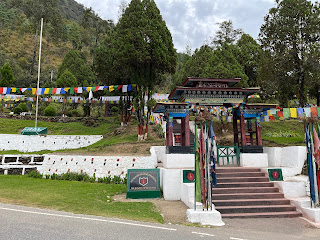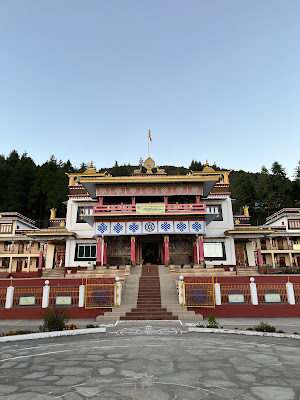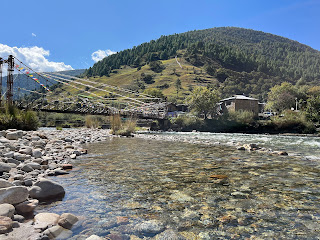We started our Arunachal Pradesh journey from the Guwahati Airport. We explored Dirang and Bomdila in Chapter 1. From there, we reached Tawang in Chapter 2. Once in Tawang, we covered the nearby places in Chapter 3. Now, in the final chapter of our Arunachal journey, we'll be going north of Tawang, along the snow-capped mountains, exploring the beauty of Himalayas and ultimately reaching the China border at the Bumla pass.
It is recommended to read journey so-far in earlier chapters before continuing.
Travel Advisory:
Tawang is at the altitude of approx. 10000 ft. The altitude will keep on increasing during the journey towards the north of Tawang. So it is advisable to get used to the altitude and climate.
Y-Junction
We started our journey towards the Gurudwara and Sungester lake at around 9 am from Tawang. After crossing the town, our upward journey continued in the mountains. While the distances in kms might look smaller, it takes reasonable time to cover these places as the entire journey is on narrow mountain roads. At about 21 kms from Tawang, there is a junction known as Y-junction. As the name suggests, there are two roads going in different directions from this place. The straight one goes towards Sungester lake while the right turn goes towards the Bumla pass.
While the climate was quite cold, to our pleasant surprise, we witnessed snow fall as we reached the Y-junction. It suddenly became too cold and we were lucky to find an army shop. We not only purchased some winter clothes, but were also offered delicious food by the jawans. The snow fall was quite heavy and we enjoyed it despite extreme cold.
Note:
- Carry extra winter clothes, including gloves, while going north of Tawang. The weather changes quite quickly here. Be extra careful if you are planning for a solo bike trip.
Gurudwara Teesri Udassi
As this was the day of Diwali, our first stop was Gurudwara Teesri Udassi. This is a small Gurudwara is located on the hill, and normally takes 20-30 minutes to climb a rather steep slope. Unfortunately, we could only go till halfway as the snowfall had made air quite thin and it became difficult to even breathe while climbing. We bowed down in respect to Guru Nanak Dev and climbed down. The langar is setup at the base only and we had a wonderful tea and sweets in the open langar.
This is the gurudwara where Guru Nanak Dev stayed during his voyage to Tibet.
T-Gompa
From the Gurudwara, we continued our journey despite snowfall and rain. We finally reached a small monastery called, Takshang Gompa (T-Gompa). This small but beautiful monastery holds a lot of significance in the Tibetan Buddhist history. When His Holiness 14th Dalai Lama escaped from Lhasa in March 1959, he entered India via this route and stayed at this monastery.
Sungester Lake
From the monastery, we started our return journey, and finally reached the famous Sungester lake. This side of Tawang is quite known for its lakes and we crossed quite a few during this trip. While we didn't spend much time at other lakes due to lack of time, we did explore the beautiful Sungester lake. We had our lunch in a small cafe/restaurant near the lake. Thankfully the rain had stopped by now which allowed us to spend some quality time here. A collection of submerged black trees give this lake a distinct look. The lake became famous after the shooting of movie Koyla here, starring Madhuri Dixit. Therefore this lake is also known as Madhuri lake.
Sungester lake was created by an earthquake in 1973.
While the water is quite cold, you can explore the lake surroundings and enjoy the scenic beauty. Clear lake water surrounded by mountains makes it quite a picturesque location. Here also there is an army camp that offers winter clothes and other accessories at quite an affordable prices.
After Sungester lake, we finally headed towards Tawang and it became quite dark by the time we reached back at 4:30 pm. Our BRO friends invited us to their temple for the celebration of Diwali in the evening. This Diwali celebration in BRO campus will remain one of the most memorable event of our trip.
Bum La
As the roads near border area were closed due to heavy snow fall, we spent next few days exploring places nearby Tawang as highlighted in Chapter 3. This also allowed ourselves getting used to the climate. Finally, we started our journey towards the Bumla pass one morning. Being a sensitive border area, you'll need to obtain a permit to go to Bum La. This can be obtained online.
We again crossed the Y-junction and this time took the right turn towards Bum La. While the road to Bum La was open, the vehicle movement was quite slow due to earlier snowfall. It took us more than 2 hours to finally reach Bumla. We crossed beautiful snowcapped mountains and Joginder Singh Memorial along the route.
At 15,200 ft, Bum La is one of the highest border pass, and road to Bumla is maintained by BRO under Project Vartak. There is a reception area where visitors wait while waiting for their batch. Nice hot soup, samosa and kaju katli is available in the canteen here. You can see the border from the reception room glass window. As our number came, we walked up to the India-China Border gate on a small road under the guidance of an army officer. Photography is not permitted here. The officer passionately told about the history of Bumla, 1962 war and the sacrifice of Subedar Joginder Singh. There was a layer of thick snow all round and therefore there is no fencing along this border. The climate changes suddenly here and it can become quite cold within a few minutes.
Subedar Joginder Singh was awarded Param Vir Chakra for his bravery during the battle of Bum La on 23 October 1962.
The air of Bum La still smells the sacrifices of brave Indian soldiers of the battle fought 60 years ago. The battle is still on for the soldiers here as they face the harsh weather and a hostile neighbor. It is quite unfortunate for a heaven like Bum La to remain a politically sensitive area.
We had a plan to go up to the holy Chumi Gyatse waterfall along the India-China border and spend a night there. Unfortunately, the roads were closed due to heavy snowfall on that route. We therefore returned back to Tawang from Bum La. There is always something left for which we may return to this mesmerizing land again in future.
As we reach end of our journey, again a moment of appreciation for the BRO (Border Road Organization) that takes care of the road infrastructure in this difficult terrain. Many thanks to Gaurav Gupta sir, Rakesh Bhatti sir, Zuber Ahmad Sir and others from BRO whose warmth and hospitality we'll never forget.
Our good friends, Nini and Jay whom we met during this trip, have covered the places of Tawang quite beautifully in their vblog here -













































